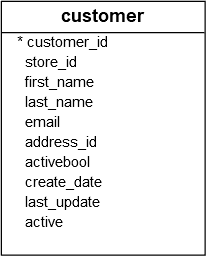PostgreSQL WHERE
Summary: in this tutorial, you will learn how to use PostgreSQL WHERE clause to filter rows returned by a SELECT statement.
Introduction to PostgreSQL WHERE clause
The SELECT statement returns all rows from one or more columns in a table. To retrieve rows that satisfy a specified condition, you use a WHERE clause.
The syntax of the PostgreSQL WHERE clause is as follows:
SELECT
select_list
FROM
table_name
WHERE
condition
ORDER BY
sort_expression;In this syntax, you place the WHERE clause right after the FROM clause of the SELECT statement.
The WHERE clause uses the condition to filter the rows returned from the SELECT clause.
The condition is a boolean expression that evaluates to true, false, or unknown.
The query returns only rows that satisfy the condition in the WHERE clause. In other words, the query will include only rows that cause the condition to evaluate to true in the result set.
PostgreSQL evaluates the WHERE clause after the FROM clause but before the SELECT and ORDER BY clause:
 If you use column aliases in the
If you use column aliases in the SELECT clause, you cannot use them in the WHERE clause.
Besides the SELECT statement, you can use the WHERE clause in the UPDATE and DELETE statement to specify rows to update and delete.
To form the condition in the WHERE clause, you use comparison and logical operators:
| Operator | Description |
|---|---|
| = | Equal |
| > | Greater than |
| < | Less than |
| >= | Greater than or equal |
| <= | Less than or equal |
| <> or != | Not equal |
| AND | Logical operator AND |
| OR | Logical operator OR |
| IN | Return true if a value matches any value in a list |
| BETWEEN | Return true if a value is between a range of values |
| LIKE | Return true if a value matches a pattern |
| IS NULL | Return true if a value is NULL |
| NOT | Negate the result of other operators |
PostgreSQL WHERE clause examples
Let’s practice with some examples of using the WHERE clause.
We will use the customer table from the sample database for demonstration.

1) Using WHERE clause with the equal (=) operator example
The following statement uses the WHERE clause to find customers whose first name is Jamie:
SELECT
last_name,
first_name
FROM
customer
WHERE
first_name = 'Jamie';Output:
last_name | first_name
-----------+------------
Rice | Jamie
Waugh | Jamie
(2 rows)2) Using the WHERE clause with the AND operator example
The following example uses a WHERE clause with the AND logical operator to find customers whose first name and last names are Jamie and rice:
SELECT
last_name,
first_name
FROM
customer
WHERE
first_name = 'Jamie'
AND last_name = 'Rice';Output:
last_name | first_name
-----------+------------
Rice | Jamie
(1 row)3) Using the WHERE clause with the OR operator example
The following example uses a WHERE clause with an OR operator to find the customers whose last name is Rodriguez or first name is Adam:
SELECT
first_name,
last_name
FROM
customer
WHERE
last_name = 'Rodriguez'
OR first_name = 'Adam';Output:
first_name | last_name
------------+-----------
Laura | Rodriguez
Adam | Gooch
(2 rows)4) Using the WHERE clause with the IN operator example
If you want to find a value in a list of values, you can use the IN operator.
The following example uses the WHERE clause with the IN operator to find the customers with first names in the list Ann, Anne, and Annie:
SELECT
first_name,
last_name
FROM
customer
WHERE
first_name IN ('Ann', 'Anne', 'Annie');Output:
first_name | last_name
------------+-----------
Ann | Evans
Anne | Powell
Annie | Russell
(3 rows)5) Using the WHERE clause with the LIKE operator example
To find a string that matches a specified pattern, you use the LIKE operator.
The following example uses the LIKE operator in the WHERE clause to find customers whose first names start with the word Ann:
SELECT
first_name,
last_name
FROM
customer
WHERE
first_name LIKE 'Ann%';Output:
first_name | last_name
------------+-----------
Anna | Hill
Ann | Evans
Anne | Powell
Annie | Russell
Annette | Olson
(5 rows)The % is called a wildcard that matches any string. The 'Ann%' pattern matches any strings that start with 'Ann'.
6) Using the WHERE clause with the BETWEEN operator example
The following example finds customers whose first names start with the letter A and contains 3 to 5 characters by using the BETWEEN operator.
The BETWEEN operator returns true if a value is in a range of values.
SELECT
first_name,
LENGTH(first_name) name_length
FROM
customer
WHERE
first_name LIKE 'A%'
AND LENGTH(first_name) BETWEEN 3
AND 5
ORDER BY
name_length;Output:
first_name | name_length
------------+-------------
Amy | 3
Ann | 3
Ana | 3
Andy | 4
Anna | 4
Anne | 4
Alma | 4
Adam | 4
Alan | 4
Alex | 4
Angel | 5
...In this example, we use the LENGTH() function to get the number of characters of an input string.
7) Using the WHERE clause with the not equal operator (<>) example
This example finds customers whose first names start with Bra and last names are not Motley:
SELECT
first_name,
last_name
FROM
customer
WHERE
first_name LIKE 'Bra%'
AND last_name <> 'Motley';Output:
first_name | last_name
------------+-----------
Brandy | Graves
Brandon | Huey
Brad | Mccurdy
(3 rows)Note that you can use the != operator and <> operator interchangeably because they are equivalent.
Summary
- Use a
WHEREclause in theSELECTstatement to filter rows of a query based on one or more conditions.